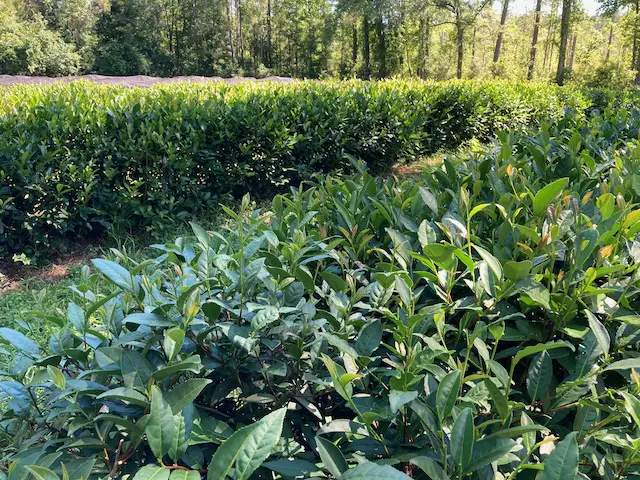
The process of crafting fine teas, which begins in the tea field and ends in the teacup, is a complex, time-honored tradition that can take many years to master.
However, the skills needed to craft pleasant, shareable teas may very well be within your grasp. Tea is the people’s drink, and the knowledge and skills required to become a master of your own tea garden and home tea factory are accessible to regular folk like you and me.
In fact, I started my tea garden with absolutely no background in tea craft. But I learned from others—while ignoring the doubters—and after nearly a decade of effort, I have my own flourishing tea garden.
And though my tea will not yet win international awards, it is most definitely enjoyable to drink and worth every drop of sweat I’ve shed while working in the garden.
Will it take you ten years to grow a tea garden? Not with my help, it won’t! You have the great benefit of learning from my mistakes and my successes. And considering that there is more interest in growing tea in the US than ever before, getting started in tea craft has never been easier.
Table of Contents
- Can you grow tea at home?
- Benefits of growing your own tea plants
- First steps in growing tea
- How is tea grown? The alternatives
- How much tea leaf can you harvest?
- How much tea can you make?
- Where is tea grown? Know your location
- Summary: First steps to growing tea
- Next decision: Grow tea plants in containers or in the ground.
- Growing tea in the garden: estimating spatial needs
- Have your tea soils professionally analyzed
- Learning is fun!
- Tea can’t swim: Soil drainage is critical
- Tea needs a drink: The importance of irrigation
- Tea likes sun but a little shade is beneficial
- Summary: can you grow your own tea?
- Think before you plant:
Can you grow tea at home?
Today I will outline the initial steps you need to take to grow the tea plant Camellia sinensis. All real teas—green, black, white, oolong, pu’er—are made from leaves of C. sinensis.
In other words, there is no such thing as a “green tea plant” or a “black tea plant” because the main difference is in the way that the tea maker processes tea leaves. You may like to drink certain kinds of tea, but as a would-be tea gardener, you need to know how to set up your garden to make all the tea types.
To help guide your planning, I have posted below crucial points that I think you should consider before you begin your tea garden. Indeed, this article is as much a should-I-do-it? self-questionnaire as it is a how-to guide to starting a tea garden.
Though delightful beverages, this post will not discuss the cultivation of herbal teas made from plants such as chamomile or peppermint.
Before we consider the details of growing tea, let’s talk about why you should even consider such an undertaking.
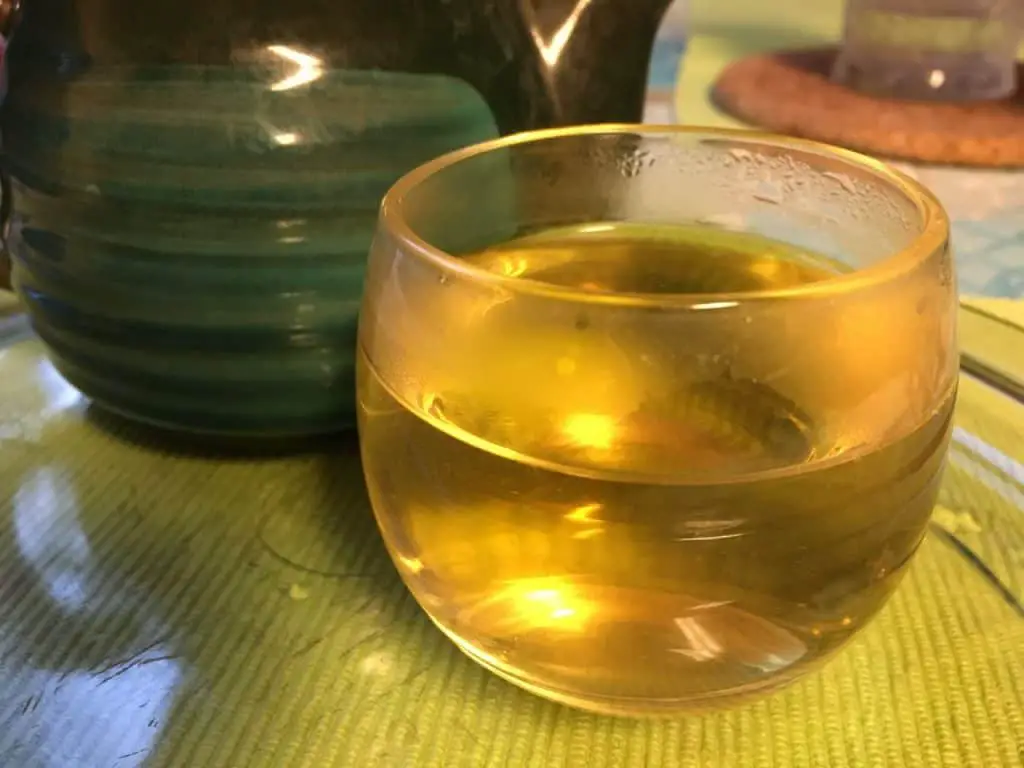
Benefits of growing your own tea plants
There are many legitimate reasons for starting a home garden. You could fill a post listing the benefits that motivate gardeners. Many of these same motivations apply to tea gardens, but with some unique aspects as well.
Here are but a few of the benefits of growing your own tea:
And besides all these great benefits, who grows and crafts their own beverages? You’ll be the coolest kid on the block!
First steps in growing tea
Now that you know why you should grow tea, let’s discuss how to determine if you have a realistic chance of creating a thriving tea garden, starting with the basics.
What is tea? Know your plant
The tea plant Camellia sinensis is a woody, long-lived shrub that can grow twenty to thirty feet tall if left unpruned.
Sometimes referred to as “tea camellia,” this species occurs naturally in forests and along forest edges where soils are rich in organic matter and minerals.
Though the history and genetic ancestry of tea are disputed, it is generally accepted that two comprehensive varieties of tea are nested within the C. sinensis species. One is a variety of tea with relatively small leaves that is originally from southern China and is designated “Camellia sinensis var. sinensis.”
This variety of tea, called the “China type,” is generally preferred by planters in cool climates though it can also tolerate some heat stress.
The other variety of tea has large leaves and is generally cultivated between Assam in eastern India to Yunnan province in southwestern China. This variety is designated “Camellia sinensis var. assamica” and often called, more simply, the “Assam type.”
The Assam type is preferred in warm, sub-tropical, and tropical areas where it never freezes in the winter.
Over the centuries of domestication, var. sinensis and var. assamica and their descendants have been crossed and backcrossed countless times. Indeed, there are by now a bewildering number of cultivated varieties of tea, each of which planters may choose to suit particular environments and improve the qualities of made tea.
Because of its capacity to endure cold and heat, most planted tea you find in the US is likely to be a variant of the China type.
How is tea grown? The alternatives
Tea camellia of all cultivars is usually planted in the field as one of three different types of material:
- Potted plants that are grown from seed.
- Transplanted from one tea field to another as bare-root seedlings.
- Rooted cuttings made from established plants.
There are pros and cons to working with each type of material. For instance, working with seeds may require a step where tea seeds are germinated in containers, which could add an expense to your budget.
Bare-root seedlings, in contrast, can be planted directly into the field, but irrigation and shade-cloth structures will be needed to get them through a warm, dry spell.
Finally, rooted cuttings make genetic copies of favored cultivars, but, take it from me, cuttings can be challenging to produce consistently.
The details of cultivating each type of material are beyond our discussion for today. For now, just keep in mind that the starting material can influence your gardening methods. Future posts will have more detailed suggestions for working with tea seeds, bare-root transplants, and cuttings.
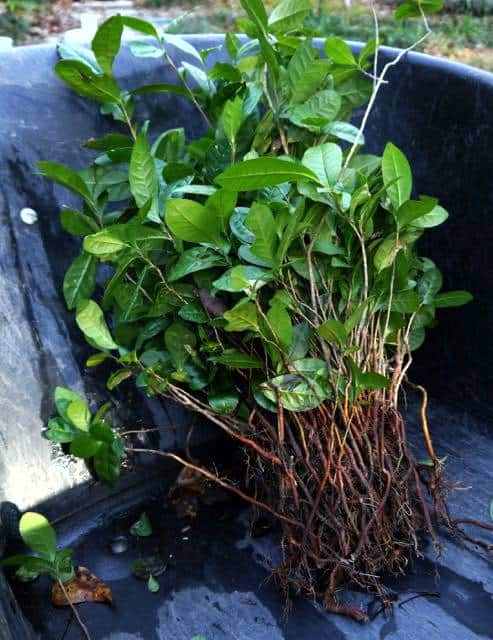
How much tea leaf can you harvest?
Before we get to the gardening lesson, let’s address a question that many would-be growers will have at the outset: How much tea leaf can you realistically expect to harvest?
If your tea plants are in good condition and you have properly pruned and shaped them, you can begin light harvests of leaf after two seasons of vigorous plant growth.
You can begin heavy harvests in the fourth or fifth season when most plants begin to reach their maximum annual yields.
Not all foliage is the same concerning the qualities of made tea. The tender tips, including the developing bud and two or three adjacent leaves, are the most versatile materials for tea makers.
Leaves located lower on the stem and of older age than the tips tend to be more brittle and harder to process into finished tea.
Oolong tea, in contrast, is often made from a semi-dormant stem and leaf combination called banji.
Harvest begins in the spring (March to April in USDA plant hardiness zone 8b, where I garden), the largest yields occur in late spring through summer (May to August), and the lightest yields are in the fall (September to October).
Leaf yield can vary quite a bit depending on the length of the growing season, the quality of your soil, and your experience as a tea grower. A generous estimate of annual yield for mature plants is about one-half of a pound of leaf per plant.
A more realistic estimate of yield is closer to one-quarter of a pound of leaf per mature plant per year. And this estimate assumes that you haven’t had any calamities in the field, such as herbivory by deer, rodents, or insects, and other ordinary gardening mishaps.
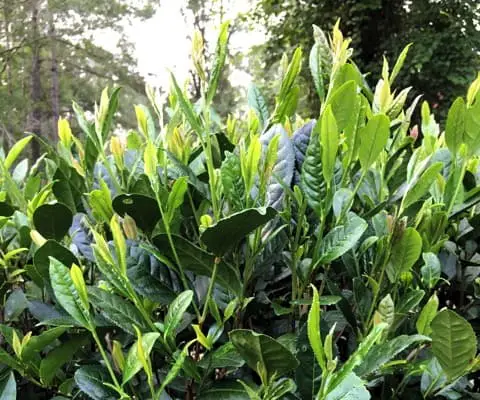
How much tea can you make?
If your tea processing is going well, then you can craft each pound of the raw leaf into, at most, about one-fifth of a pound of finished tea.
Or to factor upwards, every five pounds of the raw leaf can be made into one pound of tea ready for the cup. The 5-to-1 loss of mass between the field and the cup is primarily due to the evaporation of water that occurs during the processing steps of tea manufacture.
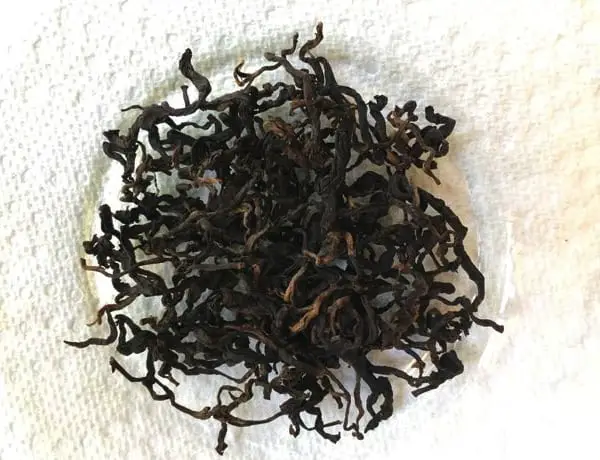
Field to cup: an example
Consider this example to see how leaf yield and conversion to tea may work out for you.
Let’s suppose that you have 50 five-year-old plants that are growing vigorously and making the maximum amount of foliage. Further, each plant yields an average of one half-pound of tea leaf over the combined course of all your harvests in the same season.
Therefore, by the end of the season, you have plucked from your 50 plants an aggregate total of 25 pounds of raw tea leaves.
After each harvest, you process the leaf into delicious finished tea. Through a 5-to-1 conversion, you obtain 5 pounds of finished tea for the entire year. Sounds great, doesn’t it?
In truth, a half-pound of leaf per plant and a 5-to-1 conversion factor of the raw leaf to finished tea are optimistic estimates for beginners. Suppose less rosy yields (e.g., one quarter-pound per plant per year) and less generous conversion if you want to be conservative in your predicted tea rewards.
Just don’t be pessimistic; you will learn how to improve yield and conversion!
Something to keep in mind: You will find that the more tea leaves you can harvest, the faster you will learn how to make good tea. But only up to a point.
For instance, I can process a single batch of one-and-a-half pounds of tea leaves into black tea at a time and just one such batch daily. The reason is that black-tea processing includes a step where you hand-roll leaves for about 50 minutes or more, which fatigues the hands and wrists.
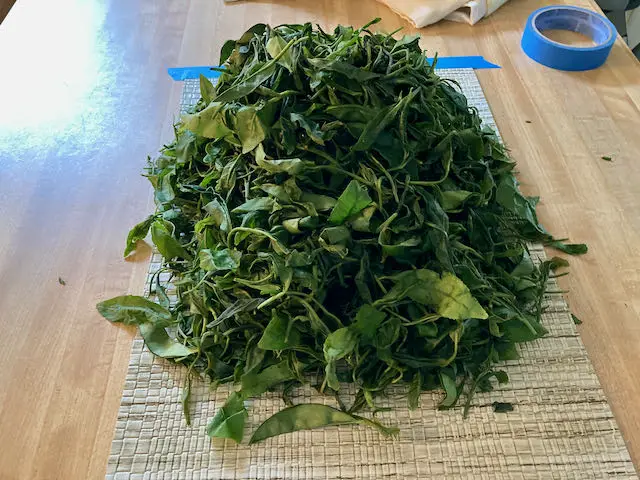
Tea that doesn’t get plucked one day has to stay on the plant to be harvested the next, which may mean a reduction in the quality of the leaf as it grows and matures.
Trade-offs such as these abound in farming, and tea is no exception. The good news, however, is that modern machinery for tea manufacture reduces the manual labor required to make tea and is now available to those with the budget.
Where is tea grown? Know your location
Tea is an adaptable plant, but it has its environmental limits. Before getting started with your tea garden, there are three guidelines to consider.
1. Mind the cold
The first consideration is the variation in the ambient temperature.
Cultivation of cold-hardy tea in the field is risky in areas where an average winter extreme low temperature is below 0°F; it is challenging between 0° and 15°F and is fairly safe above 15°F.
Note that these are the extremes of low temperatures and not events that your tea will experience every winter. But with long-lived plants such as C. sinensis, you have to consider the long view of climate because it only takes one extremely cold year to undo many years of gardening effort.
If you are unfamiliar with the climate in your area, refer to the USDA plant hardiness zone map. For example, I garden in the SE United States in zone 8b, where, in my locality, an extreme cold snap is on average between 15° and 20°F.
Although my tea garden has yet to experience such winter temperatures, during one recent winter event, the tea survived both snow and ice that stuck onto the stem and leaf for several hours.
In the tea-growing nations of Japan, South Korea, and Georgia, snow is common but not persistent through the winter. If you live where snow or ice persists for consecutive days after a storm or where the ground freezes hard, growing tea will be risky.
The lesson here is that tea, especially the China type, can tolerate cold, but it does need a break from freezing temperatures.
You can try other tea cultivars as you become more experienced in growing tea, but I recommend that beginners stick with the China type.
Living in a cold climate does not mean that you cannot grow tea. Keep reading to see what alternatives there are to dealing with frigid temperatures.
2. Tea needs warmth, humidity, and water
During the growing season, tea needs warmth, but here, too, it has limits.
I see vigorous growth in my tea garden when daytime high temperatures are between 82 and 90℉. However, I observe sluggish plant growth above that range and heat-induced stress when temperatures hit 95℉ and higher.
Many locations in the US, including much of the southeastern region, experience a similar range of temperatures. Though not as fatal for your garden as extreme cold, extreme heat can also be a serious problem.
In other parts of the US, the challenge to growing tea is low humidity.
Tea wants at least four and a half months out of the year to be warm and humid. Six months or more is better. This is the kind of climate where your clothes stick to your skin from the sweat, and your inclination towards air conditioning is very strong.
Rain often comes with high humidity, and tea needs a lot of water. I grow tea with irrigation, where the average total rainfall is about 60 inches and fairly evenly distributed across seasons.
However, late spring and early fall can be very dry, and it is during these periods when tea may experience severe stress, especially if plants are not yet established with deep roots.
If you have reliable irrigation, you can get by with 50 inches of rain for the year. Intrepid tea growers in California are trying to get by with even less rainfall than that. God bless them.

3. Look around
Related varieties of camellia have been cultivated in the US as flowering ornamentals for a long time. If there’s an established camellia-growers network in your area—be careful, these people are often fanatics!—then there’s a good chance that C. sinensis will flourish where you live.
Ask local camellia growers about the effects of heat, drought, and freeze on their camellias and what measures they have adopted to mitigate these risks.
Ornamental camellias are hardier than tea camellia, so if these growers report difficulties, then you can be sure that your tea-growing enterprise will be challenging.
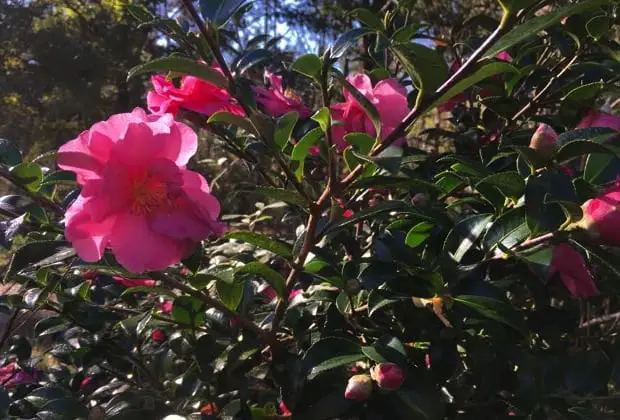
Summary: First steps to growing tea
To determine if your area is suitable for the cultivation of C. sinensis, apply the following rule, which summarizes the three criteria that I just outlined:
If during an average day in the warm season you can stand within view of a thriving ornamental camellia, and at the same time find yourself looking for either a shade tree or a swimming pool, then your area has potential as a tea-growing location!
–Mike’s Rule #1 for successful Tea cultivation–
Next decision: Grow tea plants in containers or in the ground.
You may have despaired after reading my guidelines for climate and tea cultivation. Tea won’t tolerate deep freeze or hot, droughty conditions.
But please don’t give up!
Just like many other woody shrubs, tea will grow in containers. Of course, you will have to bring your potted plants indoors during the winter, but that trouble might be worth it to you.
Indeed, some tea growers cultivate their tea in greenhouse pots in the winter and roll the plants outdoors in the summer.
Tips for growing tea plants in containers
If you choose to go the container route to tea cultivation, consider these tips:
- Anticipate that each mature tea plant will eventually need to occupy at least a five-gallon pot.
- Use a sandy-loamy potting medium that has good drainage and is on the acidic side of the pH scale.
- In the warm season, give your plant six to eight hours of sun each day but shelter the pot from harsh, direct exposure.
- Exposure to dappled sunlight under a thin shade is also acceptable to your tea plant.
- Water deeply when dry, but never saturate the potting medium for over a day.
- Maintain a happy tea plant with fertilizers for plants that prefer acidic soils.
- Prune and shape your tea plants into a frame of 4 to 6 main branches with a balloon-shaped top of smaller branches and foliage.
- Begin a light harvest of tea leaves after about three seasons of growth and then more heavily in the fifth season and beyond.
How many potted tea plants will you need?
Pot up as many tea plants as you can afford to prepare. I advise that you strive to have at least six potted tea plants in total. Six healthy, mature plants potentially yield about three pounds of tea leaf over the entire harvest season.
Of course, productivity depends on your efficiency as a tea grower and maker, but you can potentially produce about one-half to three-quarters of a pound of finished tea from six big plants in a season.
The bottom line is this: focus on maximizing the total number of healthy, potted plants. As you become more experienced growing tea, you can better predict the yield of the leaf and then organize a bigger operation.
Growing tea in the garden: estimating spatial needs
At this point, we’re still trying to determine if you have the conditions necessary to grow tea camellia.
After following the climate-restriction guidelines that I listed above, you should know if your region is too cold or too dry to cultivate tea outdoors and in the ground.
But let’s suppose that you have satisfied Mike’s Rule #1 for successful tea gardening. To wit: ornamental camellias grow in your area and it’s also warm, humid, and rainy for a good chunk of the year.
If this is the case, then congratulations! You might be able to grow tea in the ground.
But there are several important questions to consider before you start digging up the earth.
Do you have the space to plant your tea?
Tea in most commercial plantations is planted out into long rows of evenly spaced plants. As the plants mature they are shaped into a two- to four-foot-high, continuous strip of plants called a hedgerow.
Hedgerows are often preferred because this layout is an efficient use of space and labor. For one thing, mature hedgerows have a leafy canopy that shades out weeds from growing underneath.
Believe me when I say that the fewer weeds you have to deal with the happier you will be.

How many tea plants can you put in the ground?
I recommend growing tea in hedgerows but such a layout may not be cost-effective for you. Here’s a method to estimate the number of plants you can fit into your available garden space.
- Measure and combine the total horizontal length L of ground along which you want to plant hedgerows. These dimensions do not have to be straight lines; curves or angles in the hedgerows are fine.
- Divide total length L by a plant spacing S of 2 ft. This is the maximum number of tea plants P that you can put out in your row (i.e., P = L/2). For example, 50 feet of ground with 2 ft. of plant spacing will have room for 25 plants total.
- Change P by adjusting L or S. A spacing of 16 inches is probably the minimum but see below for other ideas about layout.
Next, assume that your future hedgerow plus the shoulders of the bed you prepare is 4 ft wide. Walk the length of your measured space and make sure that you have about four feet of available space across the entire length. It’s ok if there is a tree in the path of your future hedgerow; tea will appreciate a little shade.
For now, you’re concerned with estimating how much tea you can grow. Replicate this procedure for each hedgerow that you anticipate installing.
Squeezing in more tea: the double-row design
To increase the density of plants per square foot, you can create a double-row hedge.
In this scheme, two parallel rows of tea are laid out along the length of the bed rows between eighteen and thirty inches apart (you have some latitude in spacing here; use your judgment).
Plants are staggered between rows so that the final planting has a zig-zag appearance when viewed from above.
Although the increased planting density may reduce leaf output per plant, the total productivity of the hedgerow is now significantly greater than it would otherwise be with just a single-row layout.
Mike’s tea tip: You can plant your hedgerows very densely with tea. In fact, I have successfully grown a productive hedgerow with seedlings planted six abreast and spaced every 16 inches.
When the plants mature, the shade is so deep underneath the hedgerow that I never have to weed.
The downsides of high-density planting are that it takes a lot of plants to fill out the hedgerow and each plant’s growth is compromised by competition with its neighbor.
However, if you can obtain enough plant stock, I think that the balance of benefits is in favor of a super-dense hedgerow.
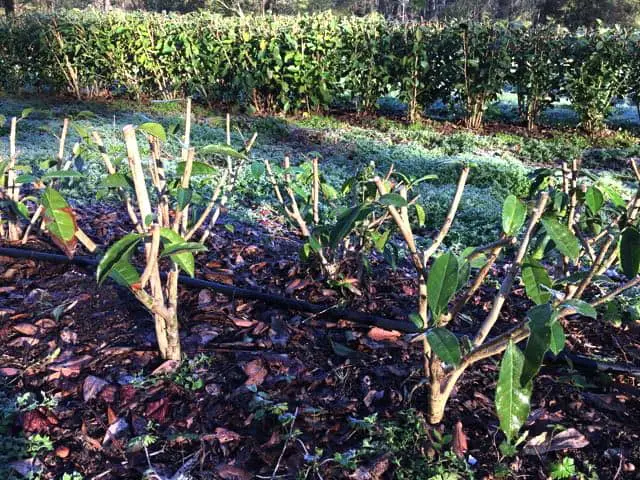
Have your tea soils professionally analyzed
Tea needs the same nutrients as other plants: nitrogen, phosphorus, potassium, and lots of different trace minerals. Although soils on the more acidic side of the pH spectrum are preferred by tea, I think it’s more important to balance nutrients, minerals, and soil organic matter before you try to adjust soil pH.
A soil analysis will indicate which nutrients you have available for plants, estimate soil pH, and report the soil’s cation exchange capacity (CEC).
CEC is important because it measures the total electrostatic attraction that the soil has for positively charged ions—i.e., cations—of nutrient atoms or molecules. Once adhered to negatively charged soil particles of clay or humus, nutrients can be “exchanged” with plant roots for hydrogen cations.
A low CEC, measured in milliequivalents (meq) per 100 grams of soil, indicates a weak capacity for the exchange of cations of potassium, iron, copper, etc. Conversely, a high CEC suggests a strong capacity to exchange these and other nutrients.
Therefore, CEC can be considered an indicator of the potential of soils to grow healthy plants.
My primary strategy for improving CEC and soil health is to copy nature by incorporating high-quality compost into the soil. For example, a percent soil organic matter (SOM) of around three in my sandy-clay soil is sufficient to achieve an effective CEC of about 10 meq (note that CEC and SOM are usually positively correlated).
I recommend that you study the basics of CEC and make sure this metric is included in your soil analysis.
Caution: some soils are not suitable for tea
A soil analysis can also put the brakes on your gardening plans.
For example, you might learn from the analysis that trace elements such as manganese or zinc are at toxic levels. If you know this information before you begin your tea project, then you can attempt soil remediation and thereby save yourself a lot of time, money, and trouble.
A more likely finding from your soil analysis is something ordinary such as too much carbon in the soil. Carbon is absolutely the backbone of organic life, but it can build up so high that nitrogen gets tied up by soil microbes that are busy digesting the carbon. In turn, plants are starved for nitrogen and show very little growth or worse.
If you know that your available garden space was previously landscaped, then use caution. Large quantities of undecomposed material such as wood chips may have been spread as mulch and then incorporated into the soil. In this case, soil microbes will work against your tea plants rather than with them.
A similar problem may arise if you incorporate composts that are not yet “finished” by bacteria that convert nutrients into forms that are bioavailable for plants.
You will know if your soil has too much carbon if the soil analysis also shows high levels of calcium. Too much of either carbon or calcium can hinder tea growth and should be remedied before starting your tea garden. As a guide, follow the professional recommendations put forth in your soil analysis.
Mike’s tea tip: Soil laboratories will tailor their recommendations for a particular crop plant, but it’s unlikely that US-based operations will have specific recommendations for Camellia sinensis. Just indicate that you’re growing generic “camellia” and then follow their advice.
Learning is fun!
Soil science is accessible to anyone with DIY sensibilities.
If you are keen on learning the applied science that links soil-mineral balance to plant health, I recommend that you study a book titled Teaming With Nutrients. In addition to explaining the essentials of soil biology and soil chemistry for farmers and gardeners, there are also directions for collecting soil samples and pointers for finding a professional soil-testing lab.
Tea can’t swim: Soil drainage is critical
There are two ways that your tea garden may have problems with water.
First, water may not quickly run off the soil surface after a rain event. Instead, water stands, or puddles, for long periods and, paradoxically, starves your plants for water.
Tea does not tolerate long-standing puddles or soggy soils.
Puddling is easy to observe: just wait for a rainstorm and watch the flow of water. Sometimes puddling is caused by a compacted layer of topsoil.
If this is the case, localized compaction can usually be remedied with various tools available at garden supply shops. If you intend to garden a large space, consider hiring a tractor with an implement called a subsoiler to break up the compaction.

A second drainage problem occurs when water cannot pass quickly through the subsoil and into the water table below.
Subsoil drainage problems occur because the water table is too close to the surface or because the subsoil lacks sufficient air space to allow water movement.
An example of poorly drained soil occurs in bogs. Boggy soils are often dense with organic matter and tend to stay damp all year. Tea will not live in bogs and so you should avoid such areas.
In contrast, tea does well in heavy clay soils but only so long as there is efficient movement of water out of the subsoil layer into which tea puts down its long taproot. Breaking up the dense clay with a subsoiler is a good idea.
In general, a water table that is six feet below the surface or deeper is preferred by tea.
Drainage solution: plant on minor slopes
Tea in different parts of the world is often planted on steep mountainsides. This is partly because it’s hard to grow anything else on such gradients but also because water drains off and away rapidly on sloped terrain.
You don’t have to find a mountainside upon which to grow your tea.
However, if I have the choice I would pick a parcel of land with a minor gradient in elevation. Too much of a gradient and gardening becomes challenging in other ways, but a gentle change in elevation across your garden, even just one or two feet of change, is sufficient.
By growing tea on a slope you may simultaneously solve the problems of standing water and poor subsoil drainage.
If soil drainage is a major concern, then consult with an agricultural engineer before you start gardening.
In general, modern agriculture and tea culture owe much of their success to solving soil-drainage issues. A consultant can offer suggestions for how to get that excess water out of your tea garden before you start to plant.
Tea needs a drink: The importance of irrigation
Too much water is a problem for growing tea, but so is not having enough.
As I said earlier, 50 inches of rainfall in a year is about the minimum that you’ll need for a strong stand of tea. And even with that amount of rainfall, I think it’s a good idea to supplement with irrigation, especially if you have recently installed plants.
As you plan your tea garden, determine if you can afford to install a drip irrigation system. A garden located within a few feet of your home will have ready access to either municipal water or well water.
If your tea garden is small, perhaps 50 plants total and arrayed in a hedgerow, then a basic irrigation kit from a home gardening center is cost-effective. But if you want to scale up your tea garden then it might be less expensive to piece together lengths of irrigation tubing and fittings that you purchase in bulk.
Not all water is the same
I irrigate my tea field from a pond that has acidic water with low mineral content. Pretty ideal for tea.
Your water supply may be different—alkaline and high mineral content, for instance—and pose problems over the long term for your tea garden. Check with your local gardening club or garden professionals to find out if there are concerns over water chemistry. They can then suggest ways to remedy water troubles such as hard, alkaline water which tends to drive up soil pH and thus hinder nutrient transfer between soil and plants.
Finally, if your garden plot is located off-the-grid or if municipal service is too costly, consider installing a solar-powered water pump. This technology is reliable, affordable, and adaptable to a range of water demands for the farm or garden.
Tea likes sun but a little shade is beneficial
In the warm season, six to eight hours of full, early-day sun is an ideal amount of exposure for tea. If by mid-day, however, the temperatures in your garden frequently hit the 90s, then your tea needs relief from the sun and heat.
Shade trees are not just beautiful additions to the garden but are also effective sunblocks for tea. For example, in Assam, India, trees with a high, thin canopy of foliage are frequently planted among tea hedgerows.
As you plan your tea garden, consider removing or planting trees to have full sun in the early day and partial sun in the middle to late day. Not only will your tea plants be pleased with the shaded relief—and tea in the cup may even improve—but you will be relieved as well when you’re working in the summer heat.
But don’t bother planting in dense forests. Where leaf yield suffers is under the deep shade of a mature forest with a closed canopy. Dappled sunlight, which tea may naturally experience when growing along on a forest edge, is always better for yield.
Summary: can you grow your own tea?
I covered a lot of important decision points regarding small-scale tea gardening. I didn’t even discuss much of the actual work you will have to do in the ground, where you get your hands dirty.
In a separate article, I will guide you through the tools and methods you’ll need to use to put your tea plants into the ground.
First things first, however. Let’s summarize the five main factors you should consider before spending one penny on your tea garden.
Think before you plant:
- Climate. Your future tea garden should be located where it is warm, humid, and rainy for at least four and a half months each year. If ornamental camellia thrives locally then even better for your tea prospects. If your area is cold or dry, then consider growing tea in containers.
- Planning your garden space. Estimate the garden space required to make the total amount of tea that you desire. Assume that the conversion of raw leaf to finished tea will disappoint at first but improve with experience. Do you have enough garden space to make a tea project worth your time and energy?
- Test your garden soil. Tea is adaptable to different soil types but it needs nutrition and trace minerals. A soil analysis will identify troublesome aspects that need attention prior to planting. Find a reliable soil laboratory and learn how to apply their recommendations for amending the soil.
- Water and drainage. A minimum annual amount of rainfall for tea is about 50 inches if supplemented with irrigation. Correct problems of standing water and poor sub-soil drainage before you start your tea garden.
- Sun. Tea needs sunlight to thrive but also benefits from dappled afternoon shade. Can you incorporate existing trees or install new ones so that your tea garden is partially shaded during the latter half of the day?
That’s it. Now do some thinking and figuring and decide if a tea garden is worth the time and expense. The process has been challenging for me but that’s because I didn’t have the benefit of what I told you here today. If you are serious about becoming a tea grower, and you meet these basic criteria, then you will succeed!
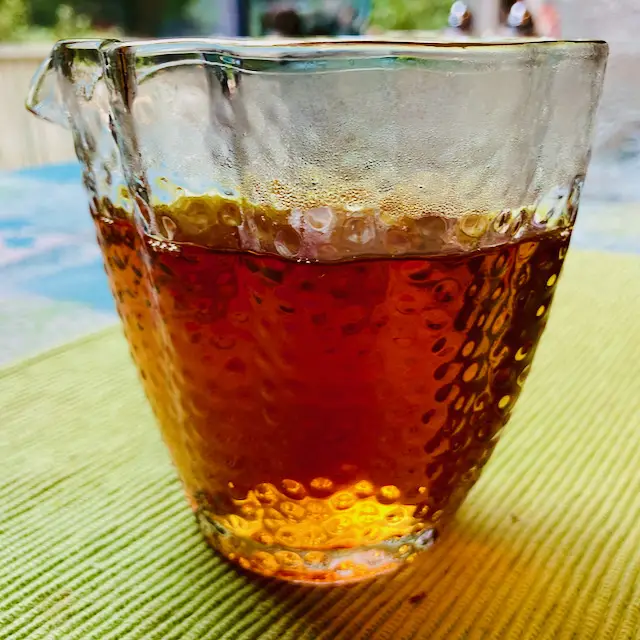
Mike grows and crafts tea in North Florida, USA. He has advanced degrees in biology, and has undertaken coursework in manufacturing Camellia sinensis teas. Mike is a member of the US League of Tea Growers (USLTG) and has presented invited talks on tea growing. Send him a note through our Contact Page if you'd like to talk about tea.
Great writeup. Maybe I missed out are all leaves suitable for green tea?
At what point do you hand-roll is there a technique to it?
Hi Kenneth. On vigorous tea bushes, most tea makers prefer the tender leaf buds and adjacent two or three developing leaves. “Two and a bud” are used for green and black teas alike. Down lower on the branch, the leaves become more coarse and harder to process but they are still useful for black tea. Rolling by hand or machine is the middle step in tea processing. Follow the link below for more here about processing. Thanks!
Field to Cup: The 4 Steps in Tea Production
Hi Mike,
Thanks for the great post. I live in an 8b area as well, and am more suburban. Would it be realistic to grow one tea plant in a container as a learning experience? I would likely be starting with a rooted or bare root plant. Would you recommend keeping it indoors during this winter and let it grow until the spring? Thanks in advance for all the help.
Hi Sam,
Camellia sinensis does fine in containers but definitely protect it from freezing temperatures and hot sun.
Hello!
Lots of info to take in! I’m in Maryland, Zone 7, and the weather is unpredictable. Some winters are mild, some not so much. Same in summer~ Humidity and shade no problem yet temperature can get to 100 degrees. Thanks for taking the time to published this great info.
The main reason I’m responding is to ask: have you ever been to the Twinings tea store in London? The tiny shop with wooden sign above has been there for hundreds of years. They have teas that go as high as 65 euros an ounce! The signs indicate where the tea is specifically from, i.e., “This tea is grown in the Szechuan region of China, must be hand-picked before sunrise, in the first week of June before the first full moon, but after an eclipse.” An exaggeration of course, but they are pretty specific! I kept my purchases to below 15 pounds per ounce! We also visited the Cutty Sark clipper ship that transported tea from Asia to London. It’s dry docked and has original cargo like tea crates, labels, etc. Lots of fun! Again, thanks for your info and enjoy the upcoming winter!
How about in-ground cultivation in north Texas? The soil is thick clay, we get 20 degree winters hit or miss over 3 month period. 6 months of San Diego weather(perfect). Then 3 months of brutal heat, 105 or higher. Would it work here? Also am very curious if any tea variety would make a decent privacy hedge along a fence or property border? Thanks!! DW